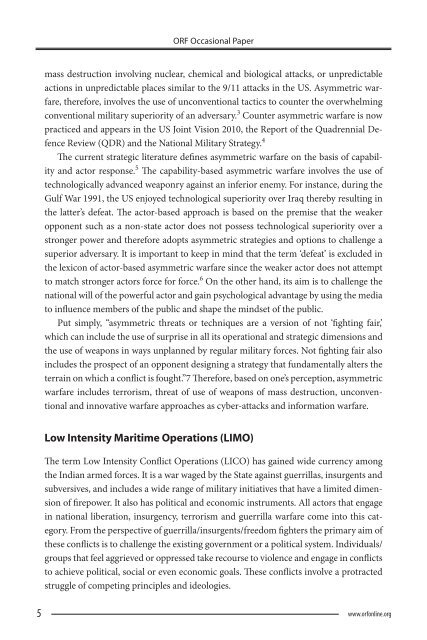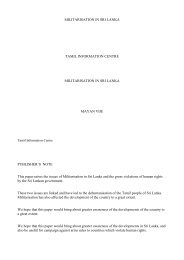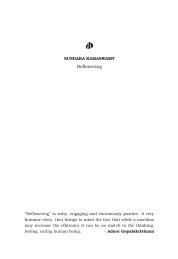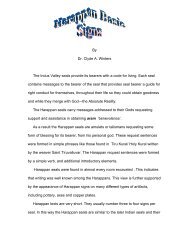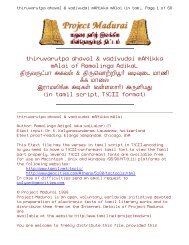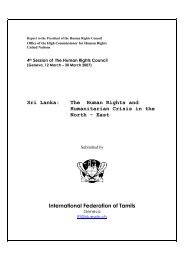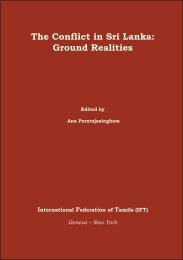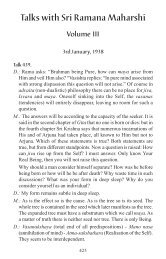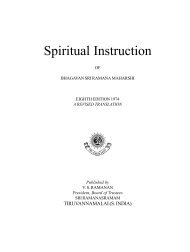Asymmetric Warfare And Low Intensity Maritime Operations
Asymmetric Warfare And Low Intensity Maritime Operations
Asymmetric Warfare And Low Intensity Maritime Operations
- No tags were found...
You also want an ePaper? Increase the reach of your titles
YUMPU automatically turns print PDFs into web optimized ePapers that Google loves.
ORF Occasional Paper<strong>Asymmetric</strong> <strong>Warfare</strong> <strong>And</strong> LIMO: Challenges For Indian Navymass destruction involving nuclear, chemical and biological attacks, or unpredictableactions in unpredictable places similar to the 9/11 attacks in the US. <strong>Asymmetric</strong> warfare,therefore, involves the use of unconventional tactics to counter the overwhelmingconventional military superiority of an adversary. 3 Counter asymmetric warfare is nowpracticed and appears in the US Joint Vision 2010, the Report of the Quadrennial DefenceReview (QDR) and the National Military Strategy. 4The current strategic literature defines asymmetric warfare on the basis of capabilityand actor response. 5 The capability-based asymmetric warfare involves the use oftechnologically advanced weaponry against an inferior enemy. For instance, during theGulf War 1991, the US enjoyed technological superiority over Iraq thereby resulting inthe latter’s defeat. The actor-based approach is based on the premise that the weakeropponent such as a non-state actor does not possess technological superiority over astronger power and therefore adopts asymmetric strategies and options to challenge asuperior adversary. It is important to keep in mind that the term ‘defeat’ is excluded inthe lexicon of actor-based asymmetric warfare since the weaker actor does not attemptto match stronger actors force for force. 6 On the other hand, its aim is to challenge thenational will of the powerful actor and gain psychological advantage by using the mediato influence members of the public and shape the mindset of the public.Put simply, “asymmetric threats or techniques are a version of not ‘fighting fair,’which can include the use of surprise in all its operational and strategic dimensions andthe use of weapons in ways unplanned by regular military forces. Not fighting fair alsoincludes the prospect of an opponent designing a strategy that fundamentally alters theterrain on which a conflict is fought.”7 Therefore, based on one’s perception, asymmetricwarfare includes terrorism, threat of use of weapons of mass destruction, unconventionaland innovative warfare approaches as cyber-attacks and information warfare.<strong>Low</strong> <strong>Intensity</strong> <strong>Maritime</strong> <strong>Operations</strong> (LIMO)The term <strong>Low</strong> <strong>Intensity</strong> Conflict <strong>Operations</strong> (LICO) has gained wide currency amongthe Indian armed forces. It is a war waged by the State against guerrillas, insurgents andsubversives, and includes a wide range of military initiatives that have a limited dimensionof firepower. It also has political and economic instruments. All actors that engagein national liberation, insurgency, terrorism and guerrilla warfare come into this category.From the perspective of guerrilla/insurgents/freedom fighters the primary aim ofthese conflicts is to challenge the existing government or a political system. Individuals/groups that feel aggrieved or oppressed take recourse to violence and engage in conflictsto achieve political, social or even economic goals. These conflicts involve a protractedstruggle of competing principles and ideologies.The non-state actors aim to weaken/challenge state authority by application of forceto an extent that it is short of conventional war. Such conflicts have proliferated in severaldeveloping countries and at times are supported, aided, abetted and directed byexternal forces to achieve political and ideological goals. To that extent, the identity ofsuch actors has also gone through a metamorphosis resulting in debates that centre onexpressions such as ‘one man’s freedom fighter is another’s terrorist/insurgent’. In India,LICO is broadly divided into three categories: internal security, counter insurgency andcounter terrorism. It is a limited politico-military action by the state to achieve political,social, economic or psychological objectives.<strong>Warfare</strong> at sea is traditionally concerned with safeguarding Sea Lines of Communication(SLOCs), maritime interdiction, sea denial, sea control, and defence of maritimeinfrastructure. The post Cold War security environment is under transformation andthe nature of future conflict at sea is undergoing a paradigm shift. These conflicts canbe categorised into linear and non-linear conflicts. 8 Linear conflicts involve conflictsbetween states i.e. historical pattern of warfare, whereas non-linear conflict are betweenthe state and the non-state/sub-state actors. The non-linear actors rely on asymmetricstrategies and their tools include terrorism, information warfare and threat of use ofweapons of mass destruction.Till the 1990s, the navies were structured to handle linear conflicts. The nuclear doctrineswere based on ‘counter value’ and ‘counter force’ targeting while the conventionalforces were tailored to engage in classical warfare involving sea control and sea denial.However, in the post-Cold War period, the spectrum of threats at sea has undergone amajor transformation. Non-state actors, terrorist groups and insurgents/militants arechallenging national security forces. These groups have modified their strategy fromlow intensity conventional terrorism to total destruction. The intensity and lethality ofattacks have also reached extreme proportions. Besides, the numbers of such groupsand networks have increased exponentially and mushroomed all over the world. Threeattacks 9 on warships in the space of a month in the year 2000 have exposed the vulnerabilityof naval vessels too. These incidents have forced naval forces to seriously reexaminethe changing nature of unconventional threats as also the tactics and the modusoperandi of its actors.Indian <strong>Maritime</strong> Doctrine: <strong>Asymmetric</strong> <strong>Warfare</strong> and LIMOIndian naval practitioners have examined the concept of asymmetric warfare and LIMO.The Indian <strong>Maritime</strong> Doctrine notes that the last decade [1990s] has seen a surge ofasymmetric attacks in which terrorists and non-state actors have carried out devastatingattacks on US warships on the coast as well as in the hinterland. The Doctrine also notes5www.orfonline.orgwww.orfonline.org 6


